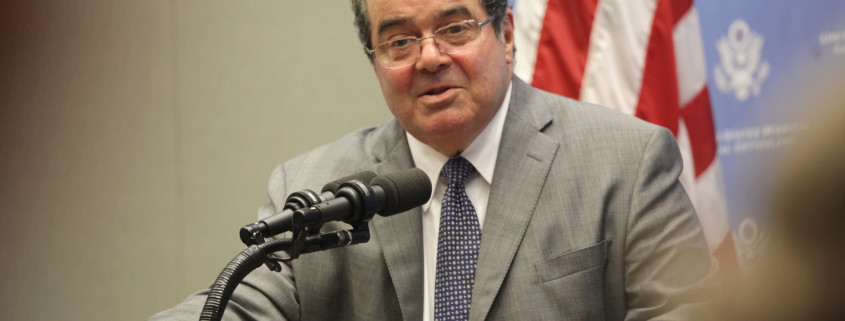Visitors Line up to Pay Tribute to Justice Scalia
By Daniel Jativa. Thomas Randall braved bitter cold temperatures and a long line Friday to make his way into the gilded lobby of the U.S. Supreme Court and pay his respects to a fellow lawyer with whom he agreed on very little.
Randall was one of hundreds of Americans who stood in a block-long line, waiting to climb the steps and pass between towering marble columns into the building where Justice Antonin Scalia lay in repose. The flag-draped casket containing the body of the 79-year-old justice rested atop the Lincoln Catafalque in the Great Hall, just outside the venerable courtroom where Scalia forged his sometimes controversial reputation as one of the most influential conservatives in the history of the high court.
“I’m a staunch liberal and I disagreed with Scalia on virtually everything, but it does not detract from his impact on the court,” Randall told FoxNews.com. “It is a shame people are trying to politicize his death on the day of his ceremony. Civil disagreement should never equate to hatred.”
By 10 a.m., the line to file past Scalia’s body wrapped around the block of First Street and East Capitol Street. As Randall spoke, and noted that Scalia himself had never allowed his conservative beliefs to affect personal friendships with the court’s liberal justices, others in line nodded in agreement. The sentiment provided a respite from a polarizing presidential campaign, the political gridlock just across the street in the United States Capitol and the debate over filling Scalia’s seat that flared as soon as word got out on Saturday that he had been found dead in his bed at a Texas ranch where he was vacationing. (Read more from “Visitors Line up to Pay Tribute to Justice Scalia” HERE)
__________________________________
Eight Is Enough (for Now)
By Jeffrey H. Anderson. To hear some on the left tell it, the Supreme Court would be hamstrung if it had to function for a year or more without a ninth justice. What to do in the event of a 4-4 tie? This would not have been viewed as a problem, however, by America’s Founders, who created a Court with an even number of justices—six. In fact, Marbury v. Madison, arguably the most important case in the Court’s 226-year history, was decided by a six-justice Court.
The Constitution, of course, leaves it up to Congress to decide how many justices will serve on the Supreme Court. In 1789, Congress passed, and President Washington signed, the Judiciary Act. That law determined that the number of Supreme Court justices should be six. The Congress of that day was full of men who had been at Independence Hall two years earlier and had participated in the writing of the Constitution, so they presumably knew what they were doing.
With a six-justice Court, a 3-3 opinion simply meant the Court wouldn’t overturn a lower federal court ruling but instead would let it stand (or wouldn’t alter the status quo in a case taken up by the Court as a matter of original jurisdiction). One effect of a six-person Court was that it took two-thirds of the Court (4 votes to 2) to declare unconstitutional a law duly passed by Congress or a state legislature. With a nine-person Court, 5-4 rulings are commonplace: In modern times, the trajectory of the nation has changed repeatedly on the personal whims of an Anthony Kennedy or a Sandra Day O’Connor. An even-numbered Court seems to be more conducive to judicial restraint. (Read more from “Eight Is Enough (for Now)” HERE)
Follow Joe Miller on Twitter HERE and Facebook HERE.




